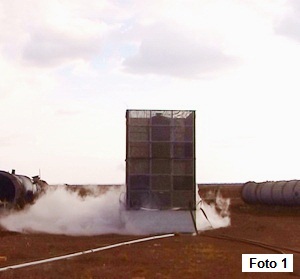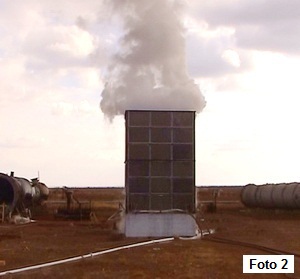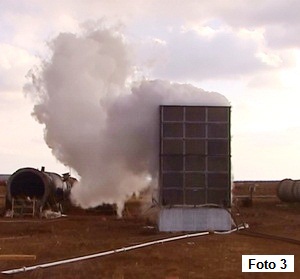|
|
Natural gas storage facilities belong to objects with a high fire danger. In the case of emergency loss of sealing of tank with this gas, forming gas clouds are poorly scattered. Since the density of these gas clouds is higher than the density of air, they float at the surface of the ground. Spreading for long distance they accumulate in natural and artificial hollows, semi-enclosed volumes, and other similar zones. When these clouds ignite, the fire covers a large area.
There are known devices designed to prevent the spread and to disperse
gas clouds forming in consequence of gas leakage from above ground
tanks.
In one of these devices (Inventor’s
Certificate of the USSR No. 1695949), when
the gas leakage occurs, a continuous fence of fire-resistant material is
created around the tank. This fence is stacked at the bottom of the tank
and spreads upward on the signal from gas sensors. The disadvantage of
this device is that the effective dispersion of the gas cloud is ensured
if the leakage of gas is small. As the rate of gas leakage from the tank
increases, the gas cloud weakly disperses above the fence. Outside the
fence, a significant part of the gas cloud moves down and spreads over
the territory of the object. Furthermore, when the gas cloud ignites
inside the fence without an explosion, the flame temperature reaches
values that far exceed the permissible temperatures and the fence is
destroyed. If the gas explodes in consequence of ignition, a
shock-deformation impulse is formed. Since the fence is continuous, it
fails under the impulse. In addition to that, the fence is not capable
of protecting the above ground tanks against strong heat flows acting
from without. Patent of the USSR No. 843704 disclose a device designed
for dispersing a gas cloud forming in consequence of leakage of
flammable and explosive heavy gases from above ground tanks. The
protection creates by forming a curtain of upward-directed steam jets
around the above ground tank. This curtain
prevents the horizontal spread of the gas cloud. In addition, the stream
jets entrain the gas behind them, which favours the dispersion of the
gas cloud. This device is not capable of dispersing the gas cloud
effectively if the leakage is large, since the steam jets entrain the
gas behind them only at the areas of contact of the gas with these jets.
In addition, this device cannot prevent the spread of
fire outside the device when the gas cloud inside the device ignites,
and also prevents the ignition of this gas cloud when strong heat flows
acted from outside. Another drawback of this device is its limited use:
it can only be used in plants where the technological steam is
available.
In 2010, M.Kh. Usmanov proposed a technical solution for
a new device for dispersing gas clouds from heavy gases produced by a
leak from a surface tank, which is free from drawbacks, which are
inherent in the above-mentioned devices.
Then, with the participation of V.L. Karpov, Doctor of
Technical Sciences, and V.Yu. Shimko, the general director of "SpetsPozTech",
the design of this device has been developed, and a model of this device
has been made. Checking of operation of this device was carried out on
the proving ground at the FGU VNIIPO of the Russian Ministry for
Emergency Situations in Orenburg.
This device is patented in Russia, China and Azerbaijan.
The patent holder is M.Kh. Usmanov.
|
|
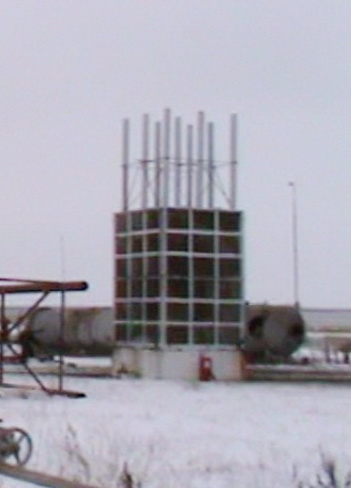
На фото - внешний вид устройства для
рассеивания газового облака, образующегося при аварийной утечке
из наземной емкости |
|
The device is a fence of heat- and
flame-protective net panels used in screens "Sogda". The top of
the device is covered with a roof made of solid material. In the
roof, there are holes in which the pipes are installed. The
device also contains gas sensors and heat flow sensors.
These fences and the roof form a closed space
around the ground tank. Due to the presence of the net fence,
under normal operating conditions the device is blown through
with air and insignificant gas vapors generated during
technological operations are dispersed without creating fire-
and explosion-dangerous gas clouds. When a leakage of gas
occurs, water sprays through the nozzles on the net panels, and
the net panels become impermeable to the gas. The formed gas
cloud moves upwards inside the fence, then through the pipes and
flows out of these pipes into the outer space, where it
disperses in consequence of mixing with the outside air. The
effectiveness of dispersion is ensured by the fact that:
a) When the gas cloud moves in pipes, it heats due to convective
heat exchange with the surrounding medium, which leads to a
decrease in its density;
b) The separation of the gas cloud into individual
streams leads to faster convective heat exchange with the
surrounding medium due to an increase in the area of contact of
the gas cloud with this medium and, accordingly, to a faster
decrease in its density.
In the case that of a gas cloud localized inside,
the device ignited without an explosion, the device prevents the
spread of fire through the territory of the object. This is
ensured by the fact that the water coating on the net fence
prevents the passing of flame beyond the net fence and also
attenuates the heat radiation of the flame to values that are
safe for objects located near the devices (the above ground
tank).
In the case that of a gas cloud localized inside,
the device ignited with an explosion, the device prevents the
spread of fire through the territory of the object. Owing to the
fact that the water coverage on the net fence is broken when a
shock wave is acted, the excess pressure is discharged through
the cells of the net fence, then the integrity of the water
cover is self-restored and the fence locates the burning of the
gas cloud.
The formation of the water cover on the net fence
and the presence of the roof lead to the damping of the
combustion of the gas cloud inside the device because of the
stopping of assess of oxygen to the combustion zone. This
property of the device is extremely important since it prevents
the destruction of the tank with gas. |
|
The device also protects the tank with liquefied
gas from dangerous heating by heat radiation from external fires
located on the territory of the object. This is due to the
above-mentioned property of the water-coated net fence to
attenuate heat radiation to safe values.
|
|
|
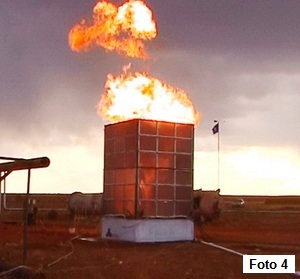 |
|
When the device is not activated, that is, there
is no supply of water to the net fence, the gas cloud spreads at
the surface of the ground and spreads through the territory
(photo 1).
When the device is activated, the gas cloud is
localized inside the enclosure and spreads upwards (photo 2).
When the rate of gas leakage from the tank is
high, the gas cloud does not have time to dissipate above the
device and moves down to the ground (photo 3). This illustrates
the ineffectiveness of known devices for scattering a gas cloud
(according to the Certificate of the USSR AS No. 1695949 and the
patent of the USSR No. 843704, which are mentioned above). The
presence of the roof with pipes on top of the net fence in the
device eliminates this drawback of the known devices.
Photo
4 illustrates the fire-protective properties of the net fence.
As noted above, the combustion rapidly dies by stopping the
access of oxygen to the combustion zone, which prevents the
destruction of the container with the gas.
|
|
|
|
|
|


